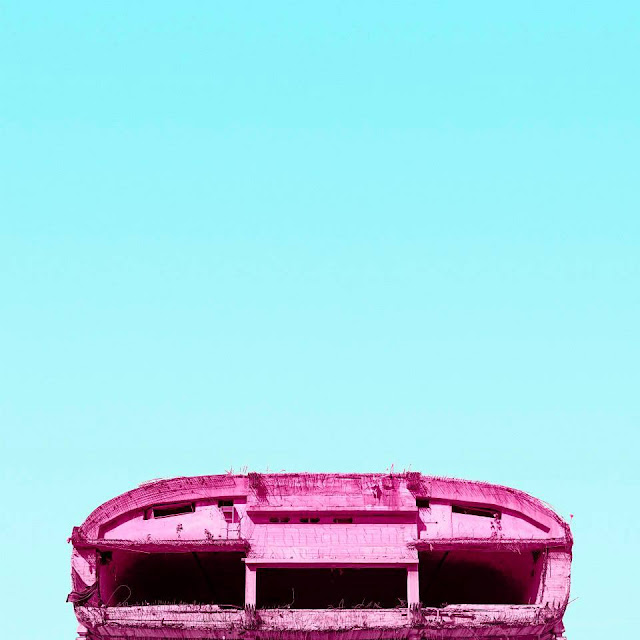Since we're in an egg-tastic mood for Easter, let's take a moment to remember the country's largest egg. Organic, totally local (but hardly fresh) - Beirut's Dome stands still, cracked just enough to survive, silently idle.
But in art, it's as alive as ever. Whether its bittersweet nostalgia or sheer political fascination, emotional attachment to it is incredibly strong. Beirut's Egg (Dome, L'Oeuf, Bayda, Sabouneh, Beirut City Centre, or whatever term or language you go by) was erected in the 1960s and continues to be a heartbroken muse for works of art, documentary, poetry and architecture. It seems that all Lebanese architects want to call dibs on the reconstruction and it's been the subject of student projects for years.
 |
| George Daou |
Center and snug right in the so-called heart of Downtown Beirut - The Egg got lucky to snag a front-row seat to Lebanon's Golden Era, its Civil War and all the turmoil, with huge-scale reconstruction and political controversy in between. But wait - the show's not over yet. With prime access to the garbage protests, it might just be starting.
This remarkable witness of an egg has had its share of glory and even more so, its share of utter sorrow. It looks so pressurized, simmering with ill-fated anxiety as though its bubbly shape might pop at the drop of a needle.
Artists have tackled the subject continuously each with their medium of choice, their unique touch, and their personal interpretation. But all the works strangely have one thing in common: they're eerie beyond belief, even when in neon pink.
Scroll down to see how this phenomenon of a structure made its way to the works of some of the country's most prolific artists.
IN GEORGE DAOU'S APOCALYPTIC SCENES
Though one would think the Egg is harmed more than it is harmful, digital artist George Daou features it as a momentous, catastrophic organism seemingly invading the city.IN INSTA-STAR MATT CRUMP'S "MINIMAL BEIRUT" SERIES
Self-proclaimed "candy-colored minimalist" and one of TIME's top 50 Instagrammers, Matt Crump hit Beirut in 2015 and collaborated with Plastik Magazine creative director Ryan Houssari for the series Minimal Beirut. A neon pink one stands out.IN MAZEN KERBAJ'S ICONIC COMIC STYLE
In an eerily-haunting panel in Mazen Kerbaj's 2013 comic book Lettre à la Mère, the Dome is cross-hatched alongside Albert Camus' opening line of "mother died today" from L'Étranger.IN ONE OF THE COUNTRY'S MOST EXPENSIVE PAINTINGS
The Egg once again takes the spotlight, this time in Lebanese painter Ayman Baalbaki's "The Beirut City Centre Egg". The painting takes inspiration from the Civil War and shows the Egg standing still in Baalbaki's impressionist style. Baalbaki lived 20 years of the war and much of his work centers on the theme of destruction, so naturally the Egg would make it into his portfolio.MAJOR FUN FACT: the painting is about to be auctioned off at auction house Bonhams' upcoming sale in April, and its estimate bid is at $85,000-142,000. According to Bonhams, "at 41, Baalbaki has achieved the highest price at auction for a contemporary Lebanese artist".
IN ANTHONY SAROUFIM'S MASSIVE CAMERA OBSCURA
The camera obscura is a centuries-old optical device and the predecessor to the camera. Through a darkened box - be it a shoe-box or a giant structure - light from outside enters through holes in the box and the actual scene outside is reproduced inside. To understand Anthony Saroufim's work, you'd have to understand the optical mechanism first. |
| Dictionnaire raisonné des sciences, des arts et des métiers |

IN HATTY PEDDER'S WORK OF LUXURY AND GLAM
In a more celebratory light, Dubai-based British artist Hatty Pedder features The Egg as the city's hotspot, dazzling with a red carpet, a horde of paparazzi and an sky-strung chandelier.The full series titled "Khosh Bosh" rebuilds Beirut's identity and all its contradictions in Hatty Pedder's whimsical style of painting. See it here
IN CAROLINE TABET'S SERIES ON BEIRUT'S LOST SPACES
Photographer Caroline Tabet explores the interior of the Dome in "Lost Spaces", a series on places that are disappearing. Haunting black-and-white images drown you with the inevitable eeriness of being inside an empty theatre - let alone the Egg.
 "
"


















